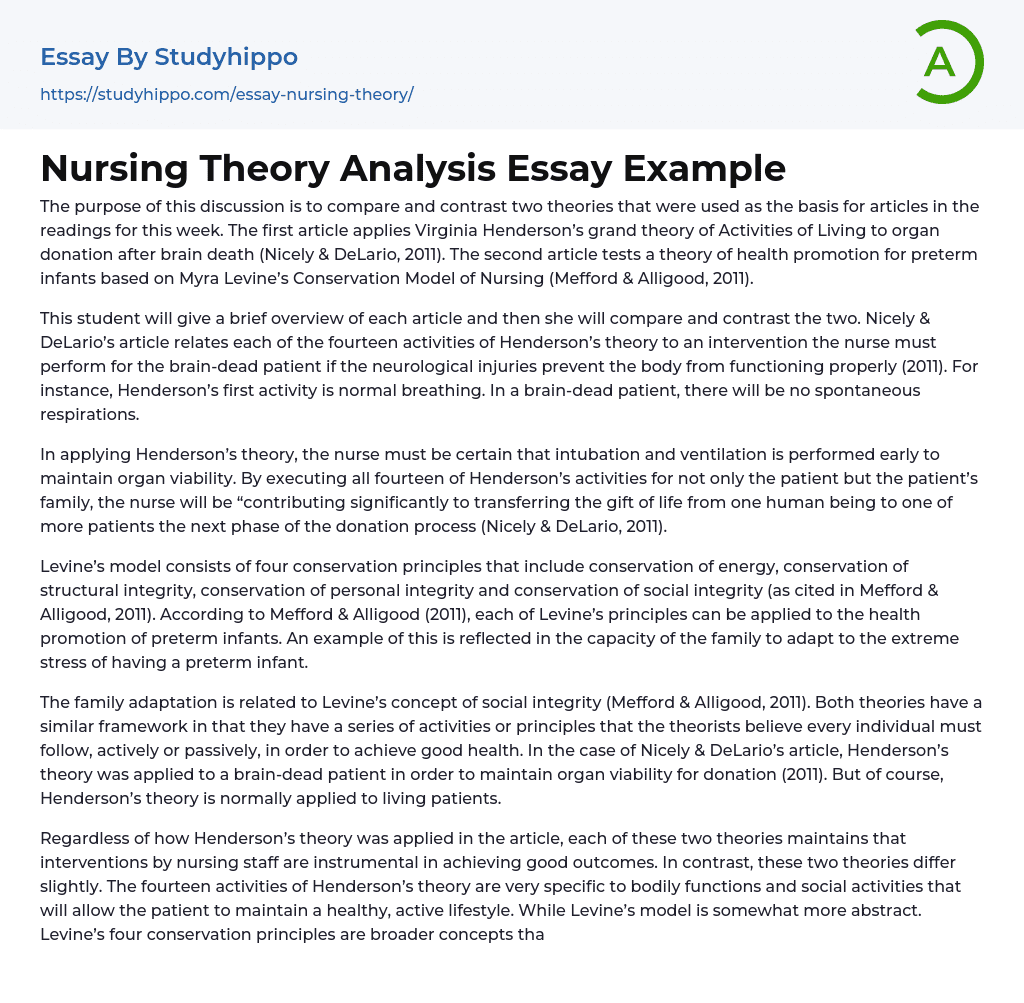The purpose of this discussion is to compare and contrast two theories that were used as the basis for articles in the readings for this week. The first article applies Virginia Henderson’s grand theory of Activities of Living to organ donation after brain death (Nicely & DeLario, 2011). The second article tests a theory of health promotion for preterm infants based on Myra Levine’s Conservation Model of Nursing (Mefford & Alligood, 2011).
This student will give a brief overview of each article and then she will compare and contrast the two. Nicely & DeLario’s article relates each of the fourteen activities of Henderson’s theory to an intervention the nurse must perform for the brain-dead patient if the neurological injuries prevent the body from functioning properly (2011). For instance, Henderson’s first activity is normal breathing. In a brain-dead patient, ther
...e will be no spontaneous respirations.
In applying Henderson’s theory, the nurse must be certain that intubation and ventilation is performed early to maintain organ viability. By executing all fourteen of Henderson’s activities for not only the patient but the patient’s family, the nurse will be “contributing significantly to transferring the gift of life from one human being to one of more patients the next phase of the donation process (Nicely & DeLario, 2011).
Levine’s model consists of four conservation principles that include conservation of energy, conservation of structural integrity, conservation of personal integrity and conservation of social integrity (as cited in Mefford & Alligood, 2011). According to Mefford & Alligood (2011), each of Levine’s principles can be applied to the health promotion of preterm infants. An example of this is reflected
in the capacity of the family to adapt to the extreme stress of having a preterm infant.
The family adaptation is related to Levine’s concept of social integrity (Mefford & Alligood, 2011). Both theories have a similar framework in that they have a series of activities or principles that the theorists believe every individual must follow, actively or passively, in order to achieve good health. In the case of Nicely & DeLario’s article, Henderson’s theory was applied to a brain-dead patient in order to maintain organ viability for donation (2011). But of course, Henderson’s theory is normally applied to living patients.
Regardless of how Henderson’s theory was applied in the article, each of these two theories maintains that interventions by nursing staff are instrumental in achieving good outcomes. In contrast, these two theories differ slightly. The fourteen activities of Henderson’s theory are very specific to bodily functions and social activities that will allow the patient to maintain a healthy, active lifestyle. While Levine’s model is somewhat more abstract. Levine’s four conservation principles are broader concepts that will help the patient achieve good health.
- Anatomy and Physiology essays
- Addiction essays
- Biodegradation essays
- Dental Care essays
- Disease essays
- Disorders essays
- Health Care essays
- Intelligence Quotient essays
- Nutrition essays
- Olfaction essays
- Public Health essays
- Women's Health essays
- World health organization essays
- Cancer essays
- Infectious Disease essays
- Lung Cancer essays
- Neurology essays
- Physical Exercise essays
- Medicine essays
- Sex essays
- Inquiry essays
- Disability essays
- Poison essays
- Action Potential essays
- Nervous System essays
- Childbirth essays
- Puberty essays
- Blood essays
- Kidney essays
- Neuron essays
- Body essays
- Glucose essays
- Sense essays
- Heart essays
- Skeleton essays
- Human Physiology essays
- Eye essays
- Immune System essays
- Muscle essays
- Skin essays
- Brain essays
- Central Nervous System essays
- Human Skin Color essays
- Digestive System essays
- Common sense essays
- Respiration essays
- alcoholism essays
- Smoking essays
- Casino essays
- Tobacco essays




